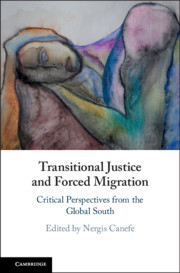Book contents
- Transitional Justice and Forced Migration
- Transitional Justice and Forced Migration
- Copyright page
- Dedication
- Contents
- Contributors
- Preface
- Acknowledgements
- Abbreviations
- In Lieu of an Introduction
- Part I The Past as the Memory of the Future
- 1 Borderlands of Independent India
- 2 A Restorative Justice Approach to the “Armenian Problem”
- 3 Hybrid Courts, Transitional Justice, and Displacement in the Global South
- Part II Law, Justice, and Hope
- Part III Ethics of Witnessing
- Index
- References
1 - Borderlands of Independent India
Transition, Violence, and Justice
from Part I - The Past as the Memory of the Future
Published online by Cambridge University Press: 24 October 2019
- Transitional Justice and Forced Migration
- Transitional Justice and Forced Migration
- Copyright page
- Dedication
- Contents
- Contributors
- Preface
- Acknowledgements
- Abbreviations
- In Lieu of an Introduction
- Part I The Past as the Memory of the Future
- 1 Borderlands of Independent India
- 2 A Restorative Justice Approach to the “Armenian Problem”
- 3 Hybrid Courts, Transitional Justice, and Displacement in the Global South
- Part II Law, Justice, and Hope
- Part III Ethics of Witnessing
- Index
- References
Summary
When the British left India, they left the country in ruins. The mutual killings had started in 1946 in Kolkata with the infamous Great Calcutta Riot. The riot left an estimated 10,000–15,000 dead in five days and 200,000 displaced. The government had to call the army to quell the riot, and this became the pattern both in the Punjab and Bengal. As the hour of independence approached, communities attacked each other in the entire northern, western, and eastern parts of the country. Acts of killing, burning, ransacking, rape, looting, maiming, and displacing spread like wildfire. The army had to be rushed to several places. What did independence mean, what was signified by freedom, and what was political power to be used for? What was sovereignty? If people were sovereign, did this mean Hindus exercising sovereignty over everyone else, or Muslims, or autonomous regions? What did the term ‘nation’ actually mean when everyone was talking of the nation gaining sovereignty, all at the same time? For the British, the main thing was getting out of India as quickly as possible and until then maintaining the minimum of law and order.
- Type
- Chapter
- Information
- Transitional Justice and Forced MigrationCritical Perspectives from the Global South, pp. 9 - 32Publisher: Cambridge University PressPrint publication year: 2019
References
- 3
- Cited by

